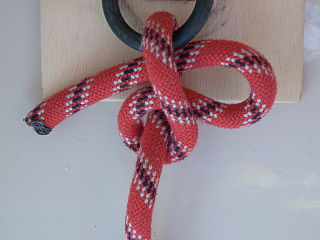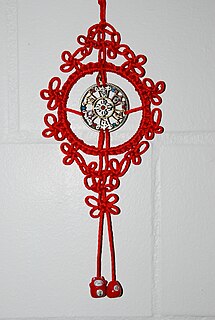
A knot is an intentional complication in cordage which may be practical or decorative, or both. Practical knots are classified by function, including hitches, bends, loop knots, and splices: a hitch fastens a rope to another object; a bend fastens two ends of a rope to each another; a loop knot is any knot creating a loop; and splice denotes any multi-strand knot, including bends and loops. A knot may also refer, in the strictest sense, to a stopper or knob at the end of a rope to keep that end from slipping through a grommet or eye. Knots have excited interest since ancient times for their practical uses, as well as their topological intricacy, studied in the area of mathematics known as knot theory.

The arabesque is a form of artistic decoration consisting of "surface decorations based on rhythmic linear patterns of scrolling and interlacing foliage, tendrils" or plain lines, often combined with other elements. Another definition is "Foliate ornament, used in the Islamic world, typically using leaves, derived from stylised half-palmettes, which were combined with spiralling stems". It usually consists of a single design which can be 'tiled' or seamlessly repeated as many times as desired. Within the very wide range of Eurasian decorative art that includes motifs matching this basic definition, the term "arabesque" is used consistently as a technical term by art historians to describe only elements of the decoration found in two phases: Islamic art from about the 9th century onwards, and European decorative art from the Renaissance onwards. Interlace and scroll decoration are terms used for most other types of similar patterns.

A slipped half hitch is a knot in which the weight of the load the rope carries depresses the loop sufficiently to keep it in place until the load item is placed in its location. When no longer required the free end may be pulled and draw the loop through and so release the load.

The diamond knot is a knot for forming a decorative loop on the end of a cord such as on a lanyard. A similar knot, also called the diamond knot, is a multistrand stopper knot, that is similar in appearance. To avoid confusion, it is advisable to call this knot the knife lanyard knot. This knot is a four strand diamond knot implemented in two strands. The knife lanyard knot is "tied alike" the Chinese button knot, "but they are worked differently."
The sailor's knife lanyard knot, also called marling-spike lanyard knot, single-strand diamond knot, two-strand diamond knot, and Bosun's whistle knot.

Chinese knotting, also known as zhongguo jie and decorative knots in non-Chinese cultures, is a decorative handcraft art that began as a form of Chinese folk art in the Tang and Song dynasty in China. This form of craft originated and was derived from the Lào zi culture which already existed in China since the ancient times. As a form of art, it is also called Chinese traditional decorative knots. Chinese knotting was later popularized in the Ming and spread to Japan and Korea. There are many different shapes of Chinese knots, the most common being butterflies, flowers, birds, dragons, fish, and even shoes. Culturally they were expected to ward off evil spirits similar to bagua mirrors or act as good-luck charms for Chinese marriages. Around the times of the Chinese new year festival, Chinese knot decorations can be seen hanging on walls, doors of homes and as shop decorations to add some festival feel. Usually, these decorations are red in colour, which is a colour associated with "luck" in traditional Chinese culture. They are also used to make the pan kou, the Chinese buttons, which are used to decorate the cheongsam.

A stopper knot is a knot that creates a fixed thicker point on an otherwise-uniform thickness rope for the purpose of preventing the rope, at that point, from slipping through a narrow passage, such as a hole in a block. To pass a rope through a block, or hole, is to reeve it. To pull it out is to unreeve it. Stopper knots prevent the rope from unreeving on its own.

In architecture and decorative art, ornament is a decoration used to embellish parts of a building or object. Large figurative elements such as monumental sculpture and their equivalents in decorative art are excluded from the term; most ornaments do not include human figures, and if present they are small compared to the overall scale. Architectural ornament can be carved from stone, wood or precious metals, formed with plaster or clay, or painted or impressed onto a surface as applied ornament; in other applied arts the main material of the object, or a different one such as paint or vitreous enamel may be used.

Korean knots, also known as maedeup (매듭), is a traditional Korean handicraft which dates back to the Three Kingdom periods that is closely related with Chinese knots.
An oriental rug is a heavy textile made for a wide variety of utilitarian and symbolic purposes and produced in "Oriental countries" for home use, local sale, and export.

In art and iconography, a motif is an element of an image. The term can be used both of figurative and narrative art, and ornament and geometrical art. A motif may be repeated in a pattern or design, often many times, or may just occur once in a work.

Alexander Leonidovich Dvorkin is a Russian anti-cult activist. From 1999 to 2012 he was professor and head of the department of the study of new religious movements (cults) at Saint Tikhon's Orthodox University. He is currently professor of department of missiology at that university.

Solomon's knot is a traditional decorative motif used since ancient times, and found in many cultures. Despite the name, it is classified as a link, and is not a true knot according to the definitions of mathematical knot theory.

Soumak is a tapestry technique of weaving sturdy, decorative fabrics used for rugs, domestic bags and bedding, with soumak fabrics used for bedding known as soumak mafrash.

The friendship knot is a decorative knot which is used to tie neckerchieves, lanyards and in Chinese knotting.

Anatolian animal carpets represent a special type of pile-woven carpet, woven in the geographical region of Anatolia during the Seljuq and early Ottoman period, corresponding to the 14th–16th century. Very few animal-style carpets still exist today, and most of them are in a fragmentary state. Animal carpets were frequently depicted by Western European painters of the 14th–16th century. By comparison of the few surviving carpets with their painted counterparts, these paintings helped to establish a timeline of their production, and support our knowledge about the early Turkish carpet.
Mingachevir Church Complex is a Caucasian Albanian Apostolic Church complex belonging to the 4th and 7th centuries which were discovered during the construction of Mingachevir Hydroelectric Power Plant in 1946. The complex was built on the basements of an ancient Zoroastrian temple.

The Pan Chang Knot is one of the eight symbols of Buddhism. It communicates that religions belief in a cycle of life with no beginning and no end. It was illustrated in a painting of the Emperor Xiaozhong that is now in the Palace Museum in Beijing. The knot is also known as the Mystic Knot, and is believed to impart good fortune to those who wear and observe it. It is an intricate knot that forces the tyer to think in three dimensions.

The Good luck knot can be seen in images carved on a statue of the Asian Goddess of Mercy, Guanyin, which was created between AD 557 and 588, and later found in a cave in northwest China.

Lào zi, also called Tāo zi, is an ancient appellation for knots in China. In ancient Chinese literature, the Lào zi actually refers to what is now known as zhongguo jie in Chinese and Chinese knotting in English. The term "Chinese knotting" only became known in recent years when it was summarized by Lydia Chen in the 1980s. It was a tradition to use the lào and/or tāo as a form of yaopei in Hanfu where it was tied to the waist by using silk or cotton ribbon.

















